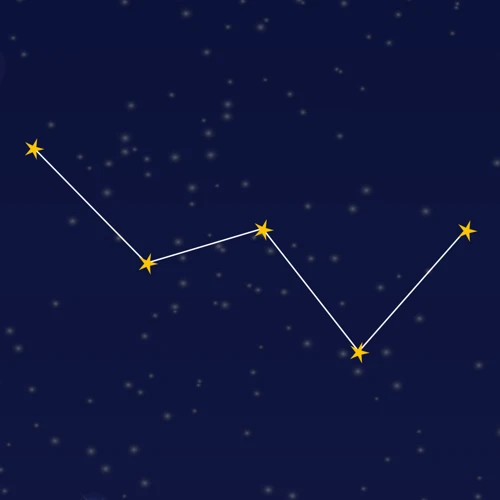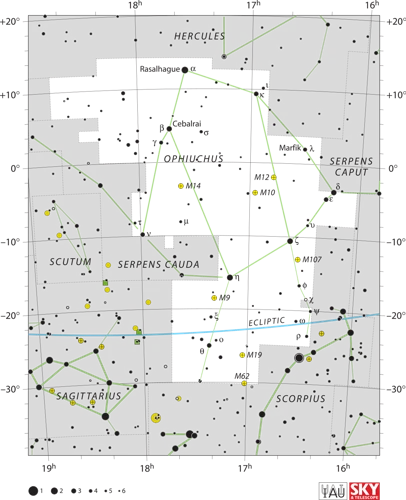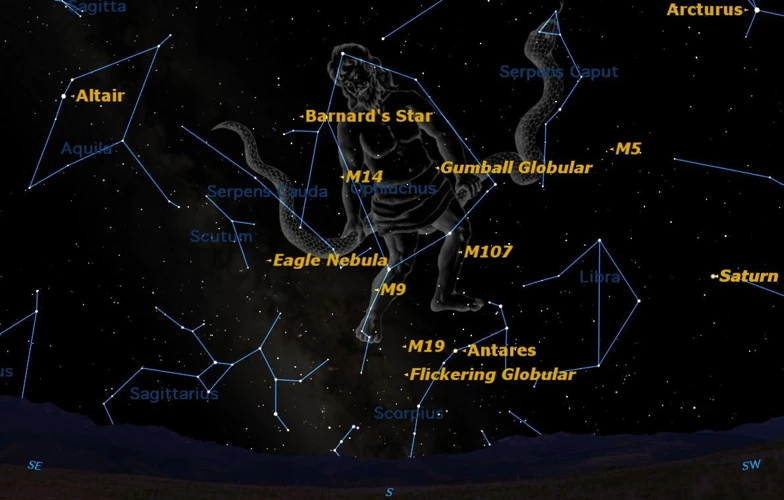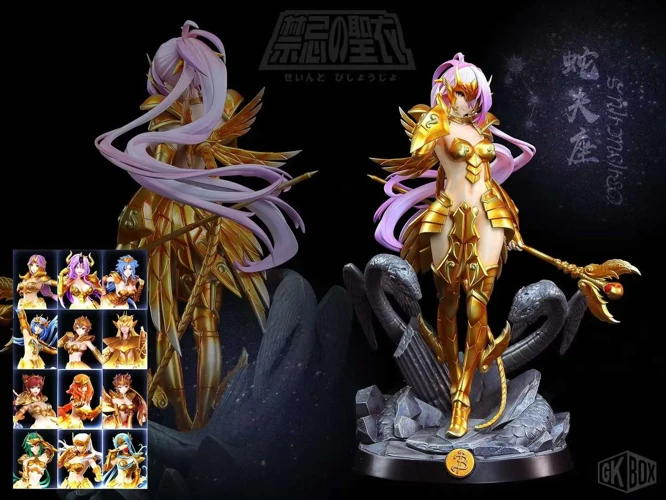Contents
- The Origin of Cassiopeia and Cepheus
- The Forbidden Love
- The Wrath of the Gods
- The Sacrifice
- The Bonds of the Sky
- The Legacy Lives On
- Conclusion
-
Frequently Asked Questions
- 1. What are constellations?
- 2. How were constellations named?
- 3. Are Cassiopeia and Cepheus visible in the night sky?
- 4. How did Cassiopeia and Cepheus become a couple in Greek mythology?
- 5. What is the significance of Cassiopeia and Cepheus in astronomy?
- 6. Is there a mythological connection between Cassiopeia and Cepheus and other constellations?
- 7. Are there any cultural depictions of Cassiopeia and Cepheus?
- 8. Are there any scientific discoveries associated with Cassiopeia and Cepheus?
- 9. Can we see Cassiopeia and Cepheus from every part of the world?
- 10. How have Cassiopeia and Cepheus influenced modern-day culture?
- References
-
Frequently Asked Questions
- 1. Who were Cassiopeia and Cepheus?
- 2. What are constellations?
- 3. How did Cassiopeia and Cepheus meet?
- 4. What was the prophecy that foretold the fate of Cassiopeia and Cepheus?
- 5. Why were the gods angered by Cassiopeia?
- 6. What was Poseidon’s curse on Cassiopeia?
- 7. Why did Cassiopeia and Cepheus choose to sacrifice their daughter?
- 8. What happened to Cassiopeia and Cepheus after their deaths?
- 9. How are Cassiopeia and Cepheus depicted in astronomy?
- 10. How have Cassiopeia and Cepheus been portrayed in art and culture?
- References
- Read More
The Origin of Cassiopeia and Cepheus

1. The Constellations:
Cassiopeia and Cepheus are two constellations found in the northern sky. Both constellations have been recognized by various cultures and civilizations throughout history. In Greek mythology, Cassiopeia was believed to be the Queen of Ethiopia, known for her immense beauty. Cepheus, on the other hand, was the King of Ethiopia and also the father of Andromeda, another prominent constellation in the night sky. These constellations have been named after the mythical characters to honor their legacy and eternal love.
2. The Royal Couple:
According to Greek mythology, Cassiopeia and Cepheus were a royal couple blessed with great power and prosperity. They ruled over their kingdom with wisdom and benevolence, earning the respect and admiration of their subjects. Their love for each other was legendary, and they were considered the epitome of an ideal couple. The constellations of Cassiopeia and Cepheus immortalize their love story, serving as a symbol of everlasting devotion and the enduring power of love in the face of adversity.
The Forbidden Love

1. The Fateful Encounter:
The forbidden love between Cassiopeia and Cepheus began with a fateful encounter. One day, while Cassiopeia was admiring her reflection in a pool of water, she caught the eye of Poseidon, the mighty god of the sea. Enraptured by her beauty, Poseidon approached Cassiopeia and proclaimed her as the most beautiful woman in the world. However, unbeknownst to Cassiopeia, this act would set in motion a chain of events that would test the depths of her love for Cepheus.
2. A Match Made in Heaven:
Despite the adoration of Poseidon, Cassiopeia’s heart belonged to Cepheus. The couple’s love was unwavering, and they were determined to be together despite any obstacles thrown their way. Their love was considered forbidden because Cassiopeia was already married to Cepheus, and crossing paths with a god was seen as a challenge to the divine order. However, their love only grew stronger as they defied the norms and embraced their shared destiny. Together, they became a symbol of devotion and the triumph of love over societal expectations.
The Wrath of the Gods

1. The Boastful Queen:
Cassiopeia’s beauty was renowned far and wide, and she took great pride in her appearance. In her arrogance, she boasted that she was more beautiful than the sea nymphs known as the Nereids. This claim angered the sea god, Poseidon, who decided to teach Cassiopeia a lesson.
2. Poseidon’s Curse:
Enraged by Cassiopeia’s arrogance and disrespect for his creations, Poseidon unleashed a terrible punishment upon her and her kingdom. He sent a fearsome sea monster, Cetus, to terrorize the land as a consequence of Cassiopeia’s hubris. The kingdom was thrown into chaos and despair as the monster ravaged the coastline. Cassiopeia realized her mistake and pleaded with Poseidon for mercy, but it was too late. The wrath of the gods had been unleashed, and only a great sacrifice could appease them.
The Sacrifice

1. The Oracle’s Prophecy:
In the realm of Greek mythology, no great love story is without its trials and tribulations. Cassiopeia’s undeniable beauty had stirred envy within the heart of the sea god Poseidon. As a consequence of her mother’s boastful claims, Cassiopeia faced the wrath of Poseidon, who sent a sea monster to terrorize the kingdom. Desperate for a solution, Cassiopeia sought the guidance of a wise oracle who revealed a harrowing prophecy. The oracle declared that to appease Poseidon and save the kingdom, Cassiopeia’s daughter Andromeda must be sacrificed to the sea monster.
2. A Noble Decision:
Stricken with grief and torn between a mother’s love and the fate of her people, Cassiopeia found herself faced with an impossible decision. In an act of selflessness, Cassiopeia agreed to sacrifice her beloved daughter to protect her kingdom from Poseidon’s wrath. This noble sacrifice showcased Cassiopeia’s unwavering devotion to her people, even in the face of unimaginable heartbreak. Andromeda was bound to a rock, awaiting her doomed fate, while Cassiopeia and Cepheus watched helplessly, their hearts heavy with sorrow and regret.
The Bonds of the Sky

1. Immortality and Eternal Love:
In Greek mythology, the gods were so moved by the love story of Cassiopeia and Cepheus that they decided to honor them by placing their images among the stars. As a reward for their unwavering love and devotion, the gods granted them immortality. Cassiopeia and Cepheus became celestial beings, forever bound together in the heavenly realm. Their love transcended mortal boundaries, becoming an eternal symbol of love and commitment.
2. The Starry Constellations:
To immortalize the love of Cassiopeia and Cepheus, their images were transformed into constellations. Cassiopeia, often depicted as a queen sitting on her throne, can be seen as a distinct “W” or “M” shape in the night sky, depending on its position. Cepheus, portrayed as a king holding a scepter, is located next to Cassiopeia. Together, these constellations form a celestial bond, forever connected in the vast expanse of the sky. Their presence in the night sky serves as a reminder of the enduring power of love and the eternal nature of their bond.
The Legacy Lives On

1. Cassiopeia and Cepheus in Astronomy:
The constellations of Cassiopeia and Cepheus have played a significant role in the field of astronomy. They are easily recognizable and have served as navigational aids for centuries. Cassiopeia, in particular, is notable for its distinct W shape, making it easily identifiable in the night sky. Both constellations have also been studied by astronomers to better understand the universe. They have provided valuable insights into the formation and evolution of stars, as well as galactic structure. The stars within these constellations have been classified and studied extensively, adding to our knowledge of the cosmos.
2. Cultural and Artistic Depictions:
The love story of Cassiopeia and Cepheus has captured the hearts and imaginations of people across different cultures and artistic mediums. Their tale has been retold in literature, music, and art throughout history. Artists have depicted their celestial romance in paintings and sculptures, often portraying them as elegant and regal figures. Their story has also been adapted into plays and operas, enchanting audiences with its themes of love, sacrifice, and perseverance. Their names have been referenced in various forms of popular culture, immortalizing their legacy and keeping their story alive in the modern world.
Conclusion

In conclusion, the tale of Cassiopeia and Cepheus is a testament to the enduring power of love and the strength of the human spirit. Their forbidden love, the wrath of the gods, and the noble sacrifice they made for their kingdom have resonated with people throughout history. The constellations of Cassiopeia and Cepheus continue to inspire wonder and awe, reminding us of the timeless beauty and mystery of the universe. From a celestial perspective, their story holds astronomical significance, providing astronomers and stargazers with a glimpse into the wonders of the cosmos. Furthermore, the legacy of Cassiopeia and Cepheus lives on through artistic and cultural depictions, showcasing their influence on various forms of art, literature, and folklore. As we gaze up at the night sky, we are reminded of their eternal love and the enduring legacy they left behind. Cassiopeia and Cepheus will forever be immortalized amongst the stars, a celestial tribute to their undying love.
Frequently Asked Questions

1. What are constellations?
Constellations are groups of stars that form patterns in the night sky. They have been used by ancient civilizations to navigate and tell stories about mythical figures and gods.
2. How were constellations named?
Constellations were named after mythical figures, animals, and objects from various cultures and civilizations. These names were often given based on the shape or pattern formed by the stars in the constellation.
3. Are Cassiopeia and Cepheus visible in the night sky?
Yes, both Cassiopeia and Cepheus are visible in the northern hemisphere. Cassiopeia appears as a prominent “W” or “M” shape, while Cepheus is a less distinct constellation that lies next to Cassiopeia.
4. How did Cassiopeia and Cepheus become a couple in Greek mythology?
In Greek mythology, Cassiopeia and Cepheus were said to have married due to an arranged marriage. Despite the circumstances, their love and devotion to each other grew over time, earning them a place among the stars.
5. What is the significance of Cassiopeia and Cepheus in astronomy?
Cassiopeia and Cepheus are important in astronomy as they are used as reference points for celestial navigation and stargazing. They are also part of the larger cosmic tapestry that tells the stories of ancient civilizations.
6. Is there a mythological connection between Cassiopeia and Cepheus and other constellations?
Yes, there is a mythological connection between Cassiopeia, Cepheus, and other constellations. Cassiopeia is the mother of Andromeda, another prominent constellation, and they are often depicted together in Greek mythology.
7. Are there any cultural depictions of Cassiopeia and Cepheus?
Yes, Cassiopeia and Cepheus have been depicted in various forms of art, including paintings and sculptures. Their story has also been adapted into plays, literature, and even modern-day movies.
8. Are there any scientific discoveries associated with Cassiopeia and Cepheus?
While there are no specific scientific discoveries associated with Cassiopeia and Cepheus, their constellations have played a vital role in mapping and identifying stars in the night sky, contributing to our understanding of the universe.
9. Can we see Cassiopeia and Cepheus from every part of the world?
No, Cassiopeia and Cepheus are primarily visible in the northern hemisphere. However, their specific visibility may vary depending on the observer’s location and the time of year.
10. How have Cassiopeia and Cepheus influenced modern-day culture?
The tale of Cassiopeia and Cepheus serves as a reminder of the power of love, sacrifice, and devotion. Their story has inspired countless works of art, literature, and entertainment, continuing to captivate audiences around the world.







